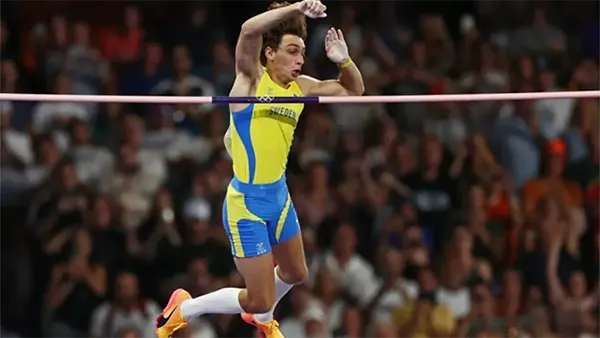Armand Duplantis has once again shifted the boundaries of modern pole vaulting by clearing 6.30 metres in 2025, strengthening his position as the leading athlete of his generation. His achievement reflects stable development, technical refinement, and a forward-looking approach to planning his competitive year. The new mark is not only a personal milestone but a significant step for the entire discipline.
Preparation Strategy Behind the 6.30 m Breakthrough
Duplantis entered the 2025 season with a training model emphasising efficiency rather than volume. His work focused on optimising approach rhythm, energy transfer on take-off, and maintaining consistent speed throughout the runway. This structure allowed him to sustain peak performance across both indoor and outdoor competitions.
The coaching team refined micro-cycles to balance strength sessions with technical jumps. Special emphasis was placed on explosive power and spatial awareness, areas that Duplantis has continually developed since his early teenage years. The 6.30 m barrier became achievable as the athlete improved his precision in plant timing and pole selection.
Superior recovery routines also played an essential role. The integration of controlled nutrition, physiotherapy support, and personalised biomechanical tests helped reduce fatigue while maintaining stability across training blocks. By 2025, Duplantis had reached a level of readiness that translated directly into exceptional competitive form.
Innovations Applied in Technique and Equipment
The 2025 season marked a step forward in Duplantis’ collaboration with equipment engineers. Adjustments to pole stiffness and weight distribution provided him with a version tailored for maximal upward projection at higher speeds. These refinements allowed smoother pole bending and faster return during the jump.
Biomechanical analysis showed that Duplantis improved his take-off angle by refining the final stride pattern. Subtle but meaningful changes in how he engaged the core and hips at the moment of lift translated into a cleaner transition above the bar. These adjustments helped stabilise his body position during flight and reduce unnecessary rotations.
Technological monitoring also became more advanced. His team used high-frame-rate diagnostics to review each attempt, identifying micro-corrections that contributed to overall consistency. The resulting dataset guided progressive enhancements through the season, ensuring the 6.30 m attempt was based on repeatable patterns rather than isolated moments of form.
Competitive Environment and Key Rivalries in 2025
The pole vault field in 2025 remained highly competitive, with several athletes consistently challenging heights above 5.90 m. Rivals such as Christopher Nilsen and KC Lightfoot maintained form that pushed the discipline forward and required Duplantis to stay technically advanced. Their presence contributed to a climate in which every major competition demanded excellence.
European competitors, including Emmanouil Karalis and Bo Kanda Lita Baehre, added strategic pressure in continental events. With strong indoor seasons and improving outdoor results, they contributed to deeper fields that limited margin for error. Duplantis approached these contests with increased analytical preparation, studying runway patterns and timing tendencies of his opponents.
The Diamond League meetings became focal points where tactical decisions influenced outcomes. Weather conditions, pole choices, and the timing of entry heights played significant roles. Despite the challenges, Duplantis’ ability to adapt rapidly under competitive stress distinguished him across the 2025 calendar.
Impact of Competition on Duplantis’ Performance
The presence of consistent challengers motivated Duplantis to maintain his technical sharpness. Regular high-pressure attempts forced him to refine decision-making under limited preparation windows. These situations strengthened his ability to manage decisive moments during crucial attempts at major championships.
External competition encouraged adjustments in training stimuli. When rivals increased their speeds and approach accuracy, Duplantis expanded his focus on acceleration phases and bar clearance efficiency. This dynamic created a positive feedback loop where competitive demands shaped training priorities.
As athletes worldwide continued to raise their standards, the pole vault scene evolved into a landscape where heights above 6.00 m became more common. Duplantis thrived in this environment by combining experience with ongoing innovation, ensuring that his leadership within the sport remained grounded in measurable progress.

Projections for the Remainder of the 2025 Season
Following his 6.30 m record, Duplantis enters the second half of 2025 with opportunities to extend his dominance at global championships and late-season circuit meetings. Analysts expect his technical consistency to provide a stable foundation for attempts at even greater heights, depending on venue conditions and competitive context.
The athlete’s progression model indicates room for further improvement in how he converts runway velocity into vertical lift. Coaches consider this factor pivotal for potential future attempts above 6.32 m, a threshold that could redefine expectations for the discipline. His capacity to maintain form through intensive travel schedules will be a determining factor.
While predictions always carry uncertainty, Duplantis’ trajectory suggests a season that may become historically significant. If he continues to combine technical refinement with strategic competition management, 2025 could be remembered as a transformative year for the evolution of pole vaulting standards.
Long-Term Outlook and Challenges Ahead
Future progress will depend on how Duplantis balances performance longevity with the natural physical demands of elite pole vaulting. Maintaining joint stability, tendon health, and overall flexibility is essential as jump heights escalate and competitive schedules intensify.
Psychological focus will also remain crucial. The pressure of sustaining world-leading status can shape mental resilience, reaction to unexpected setbacks, and motivation across multiple seasons. Duplantis’ track record suggests he is capable of navigating these challenges through structured routines and reflective preparation.
With continued innovation, disciplined training, and a strong support network, Duplantis is positioned to strengthen his legacy even further. The 2025 season, highlighted by his 6.30 m record, may become a foundation for new milestones that push the sport into another era.
